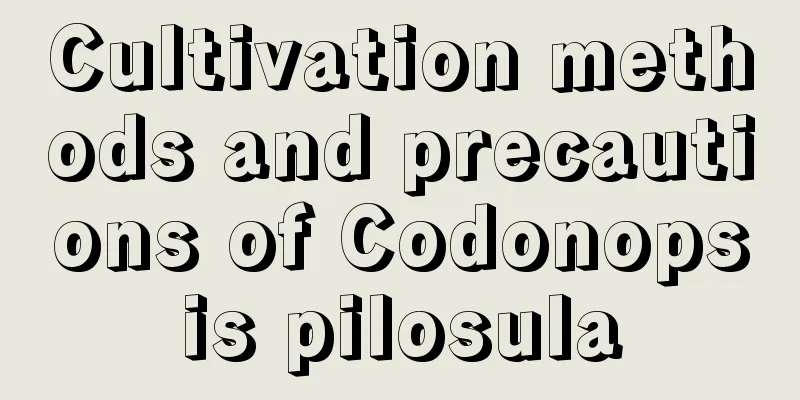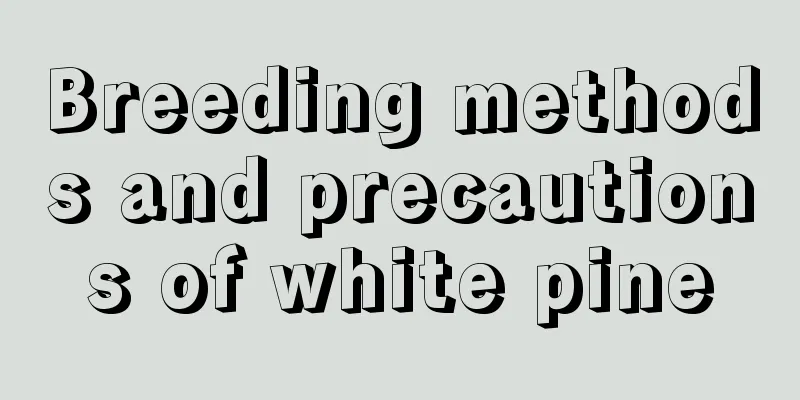Cultivation methods and precautions of Codonopsis pilosula

1. Maintenance methods1. Soil: When planting Codonopsis pilosula, you should choose soil with sufficient nutrients and good drainage. Sandy soil is the most suitable. 2. Water: During the seedling period, spray it with water to make the soil moist. When it grows to five to seven centimeters, it needs to be watered once, but there should be no stagnant water. When there is water accumulation on rainy days, it is necessary to drain it in time. 3. Nutrients: Before planting Codonopsis pilosula, you must first fertilize the soil. Generally, organic fertilizer is used. Spread the organic fertilizer evenly on the soil, and then plow the field. This can better improve the nutrients in the soil. 4. Sunlight: Codonopsis pilosula likes sunlight. Sufficient sunlight is more conducive to its growth. The planting area should face the sun to ensure better growth. 2. Breeding techniques1. Pruning: When the branches and leaves of Codonopsis pilosula grow to about one meter, in order to inhibit its growth, the tips of the branches and leaves need to be pruned. In addition, unhealthy leaves on the plants need to be cut off. 2. Weeding: Some weeds will grow in the soil during maintenance, and they need to be removed in time. Otherwise, the weeds will absorb the nutrients in the soil, and if the nutrients absorbed by Codonopsis pilosula are insufficient, its growth rate will be affected. 3. Problem diagnosis and treatment1. Pests: The main pests are red spiders and mice. Red spiders can be killed by spraying with thiamethoxam, while mice can only be killed with mousetraps or food bait. 2. Root rot: Root rot of Codonopsis pilosula is generally caused by high temperature and waterlogging. At this time, the roots need to be trimmed, and you can also use carbendazim for prevention and control. IV. Other issues1. Build a trellis: When it grows to 30cm, you need to build a trellis to allow it to grow along the way. This can reduce the occurrence of diseases and make the plant more breathable. 2. Transplantation: When transplanting, the damaged roots need to be cut off, and weak seedlings that are not growing well need to be removed to avoid nutrient consumption. |
<<: Cultivation methods and precautions of Da Cangjiaodian
>>: Cultivation methods and precautions of ground dandelion
Recommend
Is it okay not to change the soil when the money tree roots are rotten?
1. Is it possible not to change the soil? If the ...
When is the best time to plant Chinese cabbage?
Chinese cabbage is a very common vegetable . It i...
Environmental conditions and characteristics of water chestnut growth
Environmental conditions and requirements for wat...
How to Grow Strawberries Scientifically
1. Cultivation time Generally, planting is mainly...
How many years does it take for yellow peach to bear fruit?
Introduction to growing yellow peach Yellow peach...
How often should pomegranates be watered?
How often should pomegranates be watered? General...
How many years has the red light cherry produced fruit?
Introduction to planting red light cherry fruit R...
How long does it take for Clivia to bloom and when does it bloom
1. How long does it take for Clivia to bloom? Cli...
Cultivation methods and precautions of the hibiscus flower
How to grow the hibiscus flower Pot soil selectio...
Kiwifruit Management Techniques in September
As September approaches, the temperature begins t...
What are the varieties of Trachelospermum erythrorhizon
Stone Blood Also known as narrow-leaved trachelos...
What to do if your succulent first love turns black
Reasons for blackening The main reason is that th...
How to sow lavender seeds
Tools needed for lavender sowing Flower pots, see...
How to cultivate aerial root banyan bonsai
1. Use soil When cultivating aerial root bonsai, ...
Can I eat the aloe vera I grow at home? How can I eat it?
1. Introduction Aloe vera belongs to the monocoty...









